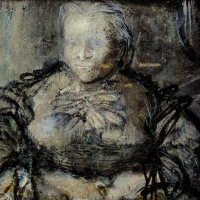68. WILLIAM DOBELL

In 1945, William Dobell moved to the small New South Wales coastal town of Wangi Wangi to seek a quieter existence. Two years before, the artist had won Australias most prestigious award for portraiture, the Archibald Prize, for his portrait of Joshua Smith. Following the artists win, two Royal Art Society members, Joseph Wolinski and Mary Edwards, took legal action against Dobell and the Gallerys trustees, alleging that the painting of Joshua Smith was mostly a caricatured form and therefore not a portrait. The subsequent court case took a toll on Dobell who was constantly under scrutiny despite the award being upheld. In response to the controversy surrounding his win and the questions raised regarding the definition of portraiture, the artist stated: to me, the sincere artist is not one who makes a faithful attempt to put on canvas what is in front of him, but tries to create something which is a living thing in itself, regardless of the subject.1
Dobells statement was a reflection of the artists beliefs and would continue to achieve in the next 25 years. His move to Wangi Wangi following the Archibald Prize controversy allowed the artist to escape the intense media focus he had endured in Sydney and he was able to begin contemplating portraiture again. One positive outcome of the controversy was the public debate about modern art in Australia and, in particular, portraiture. As a consequence, the artist was in demand as a portraitist and received many public and private commissions. One of Dobells most notable portraits from this period is Portrait of Dame Mary Gilmore 1955-57, now in the collection of the Art Gallery of New South Wales.
The present work, Study for the Matriarch c1967, was painted during a particularly productive period of his career. The 1960s saw Dobell received many portrait commissions and he took great pleasure in painting friends and supporters. Here, Scott Bevan discusses the story behind the figure in The Matriarch: This portrait was based on studies Bill had done of a Mrs Reed, whom he had met at a dance in the old Wangi RSL hall. Apparently she fitted the bill for a type Bill wanted to depict; a grandmother, even great-grandmother, like Queen Victoria. In spite of that aim, Mrs Reed agreed to be photographed on the verandah of Allawah and sat for a sketching session. The artist and Mrs Reeds connection survived the painting and flourished over flowers. The Reeds gave him cuttings from their garden, he planted and painted them.2
1. William Dobell, cited in Pearce, B., and Kolenberg, H., William Dobell: the Painters Progress, The Beagle Press, Sydney, 1997, p.74
2. Bevan, S., Bill: The Life of William Dobell, Simon and Schuster, 2005, p.97
Caroline Jones BA, MArtAdmin